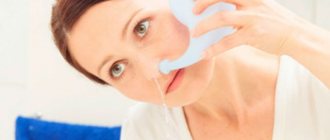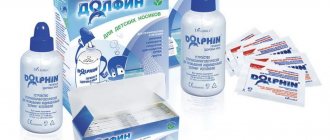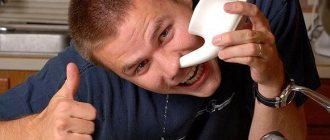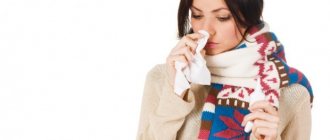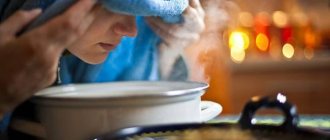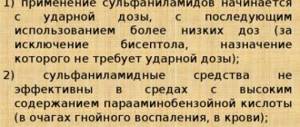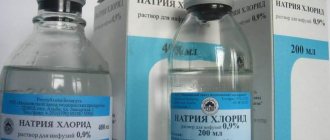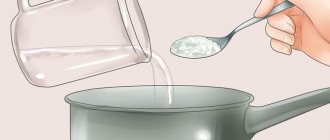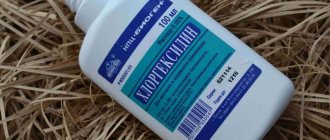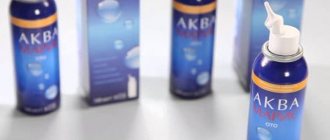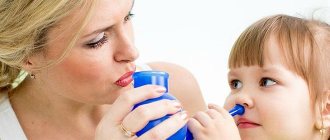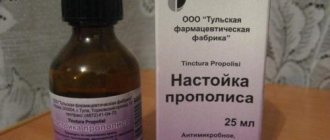Description of the product
Rotokan is a hydroalcoholic extract of 3 medicinal plants: chamomile, yarrow and calendula.
The composition of the drug is selected in such a way that the components complement and enhance each other’s effects. Thanks to this, the solution has anti-inflammatory, antiseptic, antispasmodic, wound-healing, antimicrobial and antioxidant properties. Rotokan reduces capillary permeability, enhances regeneration processes in tissues and exhibits some hemostatic effect.
Use for sinusitis
After reading the indications for use in the official instructions, the question arises whether Rotokan can be used to rinse the nose for sinusitis. Thanks to its antiseptic, anti-inflammatory and regenerating properties, such use is not only possible, but also very effective. The only caveat is that the inclusion of Rotokan in the complex therapy of sinusitis must be agreed with the attending physician.
Using Rotocan for rinsing does not exclude the need to take other medications prescribed by a doctor. The drug is only a method of auxiliary therapy that helps alleviate the course of the disease and increase the effectiveness of treatment.
Washing procedure
Rinsing your nose is not at all difficult. Although at first glance it may seem that this is a very difficult procedure. To implement this, you will need the medicinal solution itself and a device for rinsing the nose. A small syringe, a special watering can or a large syringe without a needle can handle its role.
You should be located near a sink, bathtub, or any container so that there is somewhere to pour the solution during the procedure. Your head needs to be bent forward and turned to the side. A Rotokan solution with water is taken into the rinsing device and poured into the nostril that is higher. The liquid, having washed the nasal passages, will pour out from the second nostril. Then the head is turned in the other direction and the procedure is repeated for the other nostril. If there is too much accumulated mucus, then rinsing is performed several times for each nasal passage. Upon completion of the procedure, you should blow your nose.
It must be borne in mind that this type of nasal cleansing is not very pleasant. During this procedure, irritation and burning of the nasal mucosa may occur.
To ensure more comfortable rinsing of the nose, it is necessary that the solution temperature be about 28-38 degrees. One procedure requires an average of 1 glass of solution. Perform rinsing 2-3 times a day until the condition improves, unless otherwise instructed by the doctor.
How to gargle with Rotokan for a sore throat
The herbal extract is used only in diluted form. Before preparing the rinse solution, the bottle must be shaken.
The solution is prepared using boiled water, the temperature of which is 40 degrees.
Add a teaspoon of the product to a glass of water (warm) and mix. A high-quality rinse of the pharynx and oral cavity is carried out with active movement of the tongue and facial muscles for 1 minute. The entire procedure lasts up to 8 minutes.
One portion of the solution is designed for one rinsing procedure. Similar procedures are carried out up to 5 times a day after eating for 3-4 days from the onset of the disease.
Contraindications for nasal rinsing
Rotocan has only one contraindication - individual intolerance to the components of the product. There are also age restrictions (up to 12 years), but they most likely relate to oral administration for diseases of the digestive system.
If we talk about contraindications to rinsing the nose itself, there are a few more of them:
- inflammatory process in the middle ear,
- obstruction of the nasal passages,
- frequent nosebleeds,
- tumor formations in the nose.
Nasal rinsing technology at home
The procedure is carried out using different devices. The most common methods include:
- syringe;
- kettle;
- syringe;
- bottle;
- medical devices.
Regardless of the chosen manipulation technique, their main task remains to resolve the following issues:
- removal of pathogenic microorganisms;
- relief of the inflammatory reaction;
- relieving unpleasant symptoms (swelling, mucus, nasal congestion, crusts on mucous membranes);
- liquefaction of the liquid substance with its further evacuation.
More details about swelling of the nasal mucosa are described in this material.
All methods have their own distinctive features. The main thing that unites them is the need to correctly follow the nasal rinsing technology. The lavage technique is as follows:
- take the device with liquid;
- lean forward 90° over the sink;
- inhale and hold your breath;
- apply the device to the nostril;
- lift the container with a smooth movement so that the liquid can flow out of it;
- turn your head so that the solution can flow out of the opposite nostril;
- when the healing composition stops coming out of the nasal passage, remove the device;
- repeat the same action on the other side of the nose;
- After completing the manipulation, blow your nose to remove any remaining liquid.
Depending on the cause of the runny nose, a nasal rinse is selected. An isotonic saline solution, also used for gargling, is considered universal. It is based on sea or regular table salt. You can rinse your nose with other means:
- saline;
- propolis;
- soda-salt solution;
- a solution based on salt, soda and a couple of drops of iodine;
- decoctions of herbs, for example, St. John's wort, chamomile, plantain, sage and tansy;
- warm water with honey;
- antiseptic solution based on furatsilin;
- drugs - rotokan, elekasol, malavit.
The classic recipe for a rinse is saline. Regular table salt is most often used, but it can also be replaced with sea salt, which contains many additional beneficial microelements. The solution is prepared according to the following instructions:
- take salt and warm boiled water in a ratio of 0.5 tsp. for 200 ml;
- Stir until the crystals are completely dissolved - the solution is ready.
Mineral water can also be used for the procedure. This is a good alternative to medications from the pharmacy. Mineral water contains beneficial salts and microelements that help relieve swelling and inflammation of the mucous membrane. The main condition is that it must be non-carbonated and always warm.
The easiest to prepare is a salt solution. The main thing is to make sure that its crystals are completely dissolved, otherwise there is a risk of irritation of the mucous membrane. To prevent this, you can strain the solution through cheesecloth. The procedure itself has several features:
- before starting, you need to thoroughly clean your nostrils and blow your nose;
- after washing is completed, you must not go outside or be in a draft for 1 hour to prevent infection;
- It is better to carry out the procedure over a sink or basin;
- If rinsing your nose with a saline solution does not bring relief for a long time, then you need to interrupt it and consult a doctor.
Many mothers are especially afraid to rinse the nostrils of a small child. The newborn should be placed on his side, then the liquid should be carefully dripped into one nostril. After 30-40 seconds, the solution can be sucked out using an aspirator. Older children can be irrigated. To do this, the baby is placed over the sink, and the product is injected into the nostril from a syringe. The saline solution for the nose should be slightly less concentrated so as not to dry out the delicate mucous membrane.
Typically, nasal douche solutions are prepared with only water and salt. There are rules for their preparation that must be followed:
- For rinsing, use sea salt or table salt without additives. It should not contain iodine, plant extracts, preservatives, or oils. All this can cause irritation.
- The water must be clean, without impurities. It is better to take distilled, spring, mineral or melted water.
- You can dissolve salt in cold and hot water, but you cannot heat it in the microwave - microwaves will change the structure of the salt.
It requires a liter of water and 100g of salt. The water is brought to a boil, cooled to 37 degrees and poured into a clean container. Add salt and stir until it is all dissolved. It must be used exactly one hour in advance, otherwise the properties of the mixture will be lost. The drug is contraindicated for vascular sclerosis, bleeding and a weak heart.
When making an isotonic solution, we adhere to the same rules as for hypertonic solution, but we take 9 g of salt per 1000 ml. This concentration is optimal. It is recommended to sterilize containers for preparation and storage with steam. It should be used within three days.
We adhere to all the rules mentioned above. The concentration of the hypotonic solution is 0.85% and below.
Hypotonic solutions can be prepared with furatsilin, aloe juices, Kalanchoe onions and beets.
Nasal shower
You can independently use the lavage method using a pear or a nasal mug. It consists of several stages:
- A working solution is being prepared. It may contain pharmaceutical preparations or regular table salt and soda. If desired, you can use sea water. In the first case, you can add one teaspoon of salt and half a teaspoon of soda to half a liter of water.
- The patient leans approximately 45° forward and to the side.
- The nose cup (with a spout) is brought to the nostril. It can be replaced with a regular teapot or syringe.
- Slowly pour the solution into the top hole.
- If the nasal passages are normal, it should flow out on its own through the lower nostril.
- Part of the solution may get into the mouth - this is also not a deviation from the procedure.
- The procedure is repeated for the adjacent nostril.
Rules for rinsing your nose at home:
- To carry out the procedure, it is necessary to prepare a fresh, warm solution.
- The ideal temperature of the liquid is 36-37°, as close as possible to the temperature of the human body.
- When sick, it is recommended to rinse up to 3 times a day, for hygienic purposes – daily.
- After the procedure, it is better not to go outside for 1-2 hours.
Washing is contraindicated when:
- Nose is stuffed;
- There are polyps or malignant neoplasms in the cavity;
- The nasal septum is curved (in this case, the doctor should decide whether rinsing would be useful);
- The cold is complicated by otitis media;
- The patient often experiences nosebleeds.
Contraindications for nasal rinsing
Note. It is better if a specialist first shows you how to rinse your nose correctly. This will reduce the risk of undesirable consequences and will allow you to correct errors in the procedure if they occur.
Nasal irrigation
The procedure is carried out using commercially available drugs: Dolphin, Rhinolife. During irrigation, no back draft of the solution is created; it flows out solely under the influence of gravity. This measure is one of the most gentle. It is not suitable for persons with severe nasal congestion or profuse purulent discharge.
Irrigation is also used at home. Along with the powder for preparing the solution, the kit includes a nozzle and detailed instructions for performing the procedure. The patient should be in an inclined position during nasal irrigation; this may be uncomfortable for older people. The method has no other disadvantages; it is extremely simple to implement. The patient simply needs to press on the bottle presented to the nostril until the solution flows out of the other.
The most common ingredients for nasal rinses at home are:
- Salt. It thins mucus and promotes its separation. In case of dryness, it helps maintain the water-salt balance of the nasal cavity. This substance is popularly known as a preservative. No wonder it is added to vegetables when rolled into jars. It gained such fame because it is able to stop the growth of bacteria, including pathogenic ones. The concentration of saline solution for rinsing the nose should range from 0.9% to 3%. Experts say the optimal content is 2.5%.
- Iodine. This element is a popular antiseptic. The main thing is not to overdo it with its content in the solution - 1-2 drops per glass of water will be quite enough, otherwise you can get burns to the mucous membrane.
- Soda. Doctors note that this substance has rather weak antibacterial activity, but it is quite suitable for use in combination with another stronger antiseptic.
If it is determined that the runny nose is of a non-allergic nature, then decoctions of the following herbs can be used as an alternative:
- St. John's wort. This plant contains vitamins that strengthen the cells of the nasal mucosa, phytoncides - antibacterial substances.
- Chamomile. This plant has soothing and anti-inflammatory properties. Its use is recommended for long-term diseases in which the mucous membrane is irritated.
- Sage. A decoction of this plant has anti-inflammatory and antiseptic effects. The tannins contained in the composition contribute to the healing of the mucous membrane.
- Field horsetail. Its decoctions are used as a healing and sedative. Horsetail contains a large amount of flavonoids - substances that prevent the proliferation of pathogenic flora.
- Calendula. Blooming flowers are used for medicinal purposes. The brighter their color, the higher their content of nutrients. Its decoction shows little activity against common cold pathogens - staphylococci and streptococci. But it perfectly nourishes the mucous membrane and promotes its regeneration.
The decoctions should not be made too strong; when rinsing, there should be no burning or tingling sensation.
Other ways to use Rotokan
You can find recommendations to use the drug in the treatment of sinusitis in other ways.
Only inhalation using a nebulizer can be considered safe and effective. To prepare the solution you will need 1 ml of Rotokan and 40 ml of saline. Approximately 4-5 ml of the resulting solution is used for one session. Inhalation allows you to relieve nasal congestion, reduce the manifestation of the inflammatory process and facilitate the outflow of sinus contents.
But the drug should not be used in the form of nasal drops, especially in undiluted form. Alcohol, which is the basis of the drug, causes severe burns to the mucous membrane upon contact with it.
Nasal rinses
At the pharmacy you can purchase medications designed specifically for rinsing the nasal passages. These include the following:
- Preparations based on sea salt. These include Aqua Maris, Marimer, Aqualor, Quix. They are based on water from the Atlantic Ocean or Adriatic Sea.
- Chlorhexidine. This aqueous solution exhibits bactericidal and antiseptic properties.
- Miramistin. This antibacterial drug has antiseptic and antifungal effects.
- Chlorophyllipt. An aqueous solution of this drug is used for rinsing. It has moisturizing and antibacterial properties.
- Drug Dolphin. This is a whole washing kit, including an irrigator bottle and sachets of medicine.
- Furacilin solution. Helps suppress the growth of pathogenic bacteria in the nasopharynx.
Rotokan
Separately, it is worth noting herbal preparations for washing, for example, Rotokan. It is a mixture of extracts of the following herbs:
- yarrow, which exhibits wound healing and hemostatic effects;
- chamomile, disinfectant and pain reliever;
- calendula, which has anti-inflammatory, bactericidal and wound-healing properties.
For the procedure, the drug must be diluted by taking 100 ml of warm boiled water per 5 ml of Rotokan. The positive effect will appear after a course of treatment of 1-2 weeks. It is necessary to carry out 3-5 washes daily. Indications for the use of Rotokan for irrigation are:
- treatment of rhinitis in the acute stage;
- chronic rhinitis (to prevent the development of sinusitis);
- sinusitis in the acute stage.
Such medicines include:
- Furacilin. To rinse the cavities, use a 0.02% solution. The drug has a bacteriostatic effect. It is active against the most common causative agents of colds. Its component nitrofural penetrates the microbial cell and prevents its division.
- Miramistin. The drug is available in the form of a ready-made solution with a concentration of 0.01%, which is suitable for rinsing the nose. Miramistin has a complex effect. It neutralizes bacteria and viruses, including those that are not sensitive to other drugs; promotes mucosal restoration; prevents its re-infection; activates local immunity. Miramistin is a hypoallergenic drug and is suitable for use by people prone to this disease.
- Protargol. This drug contains silver, which, when it comes into contact with mucous membranes, acts as an antiseptic. In addition, protargol forms a protective film that prevents re-infection. To rinse, add a few drops of the drug to the solution.
- Hydrogen peroxide. This compound enters into chemical reactions with biological objects (pathogenic bacteria). As a result, active oxygen is released, which triggers a series of oxidative processes. This inhibits the growth of microorganisms and reduces their number. Oxygen peroxide does not act completely, showing only a slight antiseptic effect. For rinsing, you need to use a weak solution (0.25%) or dilute 3% peroxide eleven times. Doctors warn that you should not constantly use the drug or use it to prevent colds, since it has a drying effect on the mucous membrane.
Separately, it is worth considering preparations with sea water. Their action and composition are almost identical. Such drugs include:
- Aqualor;
- Aquamaris;
- Quicks.
They differ from self-prepared saline solutions by the presence of trace elements in their composition - magnesium, potassium, selenium, iodine and others. They provide complete nutrition to the mucous membrane and increase the therapeutic effect of other nasal products used after rinsing.
